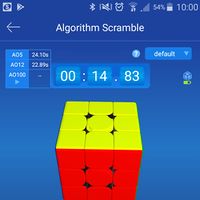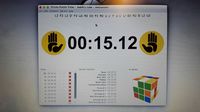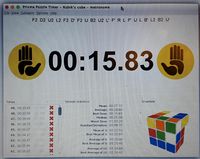Rubik's cube
| Rubik's pages on this wiki |
|---|
Guidelines for editing Rubik's Cube page on this wiki
- Use template
bkto insert Rubik's cube moves (e.g{{bk|R U R' U'}}gives R U R' U'). This ensures consistency accross pages.
- Two-turn moves are written by appending a digit
2to face letter, likeU2 F2. Don't use the notation with exponent! (likeU²), or the algorithms will be rejected by the Rubik's simulator. Using the exponent is ok to indicate that a trigger or named formula must be done twice (likeE2², meaning that E2 OLL must be done twice).
- Two-turn moves are written by appending a digit
- Use templates starting with
bk...to insert common triggers. Some of these templates are colored, and using the template guarantees that all triggers will have the same color accross pages. Note that these triggers must still be included in abktemplate.
- By default template are named according to their formula (e.g.
{{bk|{{bkrurpup}}}}for Template:Bkrurpup). - But some may have their own names, like the sexy moves (
{{bk|{{bksxr}}}}for (R U R' U')) or sledgehammers ({{bk|{{bkshr}}}}for (R' F R F')).
- Use template
{{bkft|...}}for finger tricks note (like Standard grip, first U with I, or, using the official notation, {TF,tF} U(I2)). - Always verify the algorithm using the Rubik's simulator (localhost).
Notations and acronyms
Official notation
From Wikipedia:
| F B U D L R | Front, Back, Up, Down, Left, Right (one-layer move) |
| f b u d l r | Front, Back, Up, Down, Left, Right (two-layer move, aka. wide move).
Alternate notations are Fw Bw Uw Dw Lw Rw. |
| M E S | Middle (l L'), Equator (d D'), Standing (f F') (middle layer move, aka slice move)
|
| x y z | R, U, F (whole cube move) |
- R means 90° clockwise, R' mean 90° counter-clockwise, R2 means 180° clockwise, and R2' 180° counter-clockwise.
- Alternative notation for easier pronunciation uses T (for Top) instead of U. This way all faces start with a consonnant. Using O for clockwise move, A for anti-clockwise, and I for 180° move, an algorithm like the sexy move becomes then
RoToRaTa.
Finger tricks and grips
We use DeeDubb's notation as explained on Finger_tricks speedsolving.com.
- Finger notation
| Finger notation | |||
|---|---|---|---|
| I | Right Index | i | Left Index |
| T | Right Thumb | t | Left Thumb |
| M | Right Middle | m | Left Middle |
| R | Right Ring | r | Left Ring |
| P | Right Pinkie | p | Left Pinkie |
- Piece notation
| Piece notation (corners) | |
|---|---|
| Each corner of the side being turned is labelled with the numbers 1-4 in a clockwise fashion. The front face starting with the corner UFL, the U face beginning with UBL, the D face with DFL, R with UFR, L with UBL, and B with UBR. | |
| U face | U1 = UBL, U2 = UBR, U3 = UFR, U4 = UFL |
| F face | F1 = UFL, F2 = UFR, F3 = DFR, F4 = DFL |
| Piece notation (edges, slices) | |
|
On slice moves, the numbers correspond with the edges "behind" the corners of the side with which it turns. For example M turns with the L side, and so it's edges will have the same numbers as the corresponding corners on the L face. S with the F face. E with the D face. | |
Together, the finger and piece notation form the basic finger trick notation. It is written 'move(fingerPiece)'.
- Example: U(I2) means that the right index finger performed the move U by sliding the UBR cubie to UFR.
Two-turn moves such as F2 are described using two fingers and two pieces, and can use prime to indicate direction like so: F2'(T3,i1).
- Grip notation
All grip notations are written in curly brackets ({...} ) and only when necessary to define a non-standard or non-intuitive grip. Piece specific grips are separated by a dash (e.g. T-F).
| Standard Grip | |||
|---|---|---|---|
| {TF} | (standard grip) Right thumb on Front face | {tF} | (standard grip) Left thumb on Front face |
| {TU} | (standard grip) Right thumb on Up face | {tU} | (standard grip) Left thumb on Up face |
| {TD} | (standard grip) Right thumb on Down face | {tD} | (standard grip) Left thumb on Down face |
| Non-standard Grip | |||
| {T-F} | Right thumb on front face, center piece | ||
| {T-FR,I-B1} | Right thumb on front face, FR edge; Right index on back face, 1st corner | ||
Acronyms
| AUF | Adjust Upper Face — rotate up face until it is solved, or matches a desired position. |
| AUL | Adjust Upper Layer — Same as AUF. |
| LH | Left-hand |
| RH | Right-hand |
Triggers
We call a move a permutation on the cube that can be done in a single movement. This can be the rotation of a face by 90° or 180°, but also rotation of a middle layer, two layers, or the whole cube. Each move has a dedicated letter, with a prime indicating the reverse movement.
A trigger is a small squence of moves that is frequently used to build up more complete algorithms. Typically these sequences are done very rapidly. Fast algorithms are those that link several triggers with an easy transition (no re-gripping, cube rotation, etc). The inverse of a trigger is the sequence that cancel the effect of that trigger. We use prime to denote that trigger. A mirror trigger is the M-symmetric trigger (i.e. F changes to F', R changes to L', etc)
List of triggers:
| 1 | S | Sexy move | R U R' U'
|
|
| 2 | Sp | Sexy move prime | U R U' R'
|
|
| 3 | LS | Left sexy move | L' U' L U
|
|
| 4 | LSp | Left sexy move prime | U' L' U L
|
|
| 5 | SL | sledgehammer | R' F R F'
|
F' with right thumb! |
| SLp | sledgehammer prime | F R' F' R
|
||
| 7 | LSL | left sledgehammer | L F' L' F
|
Same as y' SLp y.
|
| LSLp | left sledgehammer prime | F' L F L'
|
Same as y' SL y.
| |
| O | Overshoot | U' R' F R
|
||
| 6 | R' U R U'
|
|||
| 8 | L U' L U
|
|||
| 9 | Anti-sune | R U2 R'
|
||
| 10 | Sune | R U R' U
|
||
| 11 | R U' R' U'
|
|||
| 12 | R' U' R U'
|
- Numbering from this video.
- Badmephisto (see Andy Klise [1]) classifies triggers in three colors, from the position of prime moves:
- Red = R U R' U' family (i.e. X Y X' Y')
- Green = R U R' U family (i.e. X Y X' Y)
- Blue = R F' R' F family (i.e. X Y' X' Y)
- Andy Klise's guide use a different color coding:
- Green = R U R' U' family
- Blue = R U R' U R U2 R' family
- Orange = R F' R' F family
Tutorials
See Rubik F2L, Rubik OLL and Rubik PLL for dedicated tutorials.
Fridrich simplified
Source: Rubik's cube : Méthode intermédiaire (fridrich simplifiée)
4 steps:
- Cross
- F2L
- 2-look OLL
- 2-look PLL
For F2L, see tutorial above.
For 2-look OLL, first do the cross:
- Line shape:
F sexy F'(F' with the thumb) - L shape:
f sexy f'(f' with the thumb) - no shape: do 1st then 2nd algorithm
Then we do one of the 7 OLL "cross" algorithms. The cases are denoted by the position of yellow sticker for each corner, starting from FL, the FR, BR and BL corner. So UFRB means the yellow sticker facing upward for the left-front corner, facing front for the right-front corner, facing right for the right-back corner, and facing back for the left-back corner.
- UFRB:
R U R' U R U2 R' - FRUL:
R U2 R' U' R U' R'(inverse of UFRB) - FFUU:
R2 D R' U2 R D' R' U2 R'(D and D' ideally by pulling then pushing with left-hand finger) - LRUU:
x' R U R' D R U' R' D'(idem) (x' R→l, sol U R' D R U' R' D') (or variant UFBR:l' U' L U R U' r' F) - URUB:
x' R U' R' D R U R' D'(idem) (x' R→l, sol U' R' D R U R' D') - FFBB:
F sexy sexy sexy F' - LFBL:
R U2 R2' U' R2 U' R2 U2 R
For 2-look PLL, like for the 2-OLL, we first do the cross, then the corners. For the cross, turn the U face until 1 edge is good, and place it at F slot, and look how the other edges must be permuted.
- All edges are ok: congratulations ;-)
- clockwise:
R' U R' U' R' U' R' U R U R2'(R' U R' U'with right index under BRD corner, thenR' U' R' Uwith right index next to FRD corner) - anti-clockwise:
R2' U' R' U' R U R U R U' R(right thumb on B face, right index on FRD corner, ready for 1st U, thenR U' Rwith RH, U' with right thumb) - 2 edge ok: do either of algorithm above, and retry.
Then look at the corners. If one corner is good, turn the cube such that it is at FL slot, and look how the other corners must be permuted
- 1 good corner (FL), clockwise:
x R' U R' D2 R U' R' D2 R2orl' U R' D2 R U' R' D2 R2(usingx R'→l'). My old fingertrick was left thumb on F center, left index/middle/ring fingers on back, right thumb on U face, right index under RBD corner. First U done with right index, then D2 done with left ring+middle or left little+ring, then U' done with right thumb, like for the sledgehammer. This fingertrick is not adviced, instead train on using the left index to do the U' move [2]. - 1 good corner (FL), anti-clockwise:
x R2' D2 R U R' D2 R U' Rl' R' D2 R U R' D2 R U' R(best grip: left thumb on D face, right thumb on F face, left ring finger to prepare the D2 / D2, right index to prepare the U. - no good corner: do either of algorithm above, then you will have a good corner
Algorithms
- PLL - swap 2 edges
- R U R' U R U2 R' U
- Sexy moves and reverse, mixed with F face
- f (R U R' U') f' is reversed by f (U R U' R') f' but also by U² F (R U R' U') F'. This is true for any number of sexy moves (R U R' U') we do.
Cross
- Be color neutral.
- Do d move to avoid cube rotation might help.
Finger Tricks
- D2 move
- Use the ring and major finger. To work well, hold the cube with index and thumb such that ring and major hits the left (or right) side of the D face almost vertically. For instance, using the left hand, the index must hold both the LBU corner and LB edge, and possibly a bit the center back face and BU edge. See this video.
- Left sledgehammer
- The left sledgehammer is L F' L' F. In the right sledgehammer, the F is done with the thumb. Here it is best to do is as r U' r' F, using the LH only for the U'. Also the r can be done by pushing with the right ring finger at the bottom of the cube to avoid the re-grip (see VC 9:55).
Look-ahread
- Effect of two sexy moves ((R U R' U') (R U R' U') or (L' U' L U) (L' U' L U))
- Corners don't move but are rotated: 3 corners on the U faces and 1 corner on the D face.
- Edges keep their parity but moves: 2 edges on the U face and 1 edge on the F face.
My progress
- Short-term plan
- F2L: Practice and apply algo marked with TRAINME.
- Use x-cross for F2L cases with correct edge or correct corner when faster.
- Long-term plan
- Learn OLL (57 cases)
- Learn 2-edge PLL identification.
- Learn OLL-2-PLL identification.
- Learn partial edge control to avoid dot-OLL cases.
- Learn COLL
- To Do
- View and integrate Victor Colin's video on multi-slotting
- View / integrate video Badmephisto on OLL resolution (+partial edge control)
- View / integrate video Badmephisto on F2L.
Personal best
Questions
If I could meet a rubik expert:
- How practice F2L look-ahead? Should we first well visualize the F2L case, how to insert it, then do it? But how do we follow the position of the side color, since we might do cube rotation? Do we have to also explicitly keep track of which slot is already filled, etc?
Example of cross resolution
- Below, an example of setup move.
Scramble:
B2 R2 L2 F2 U' B2 L2 D R2 L2 U R' B' R D2 L U' R L B' D U'
yellow top, green front:
U' L2 F' L' D B L' D
-- Setup move for green
-------- We set blue and orange. Now red is ready, with green to follow nicely
------ We set red and green.
-- Adjust bottom layer



